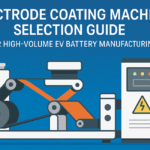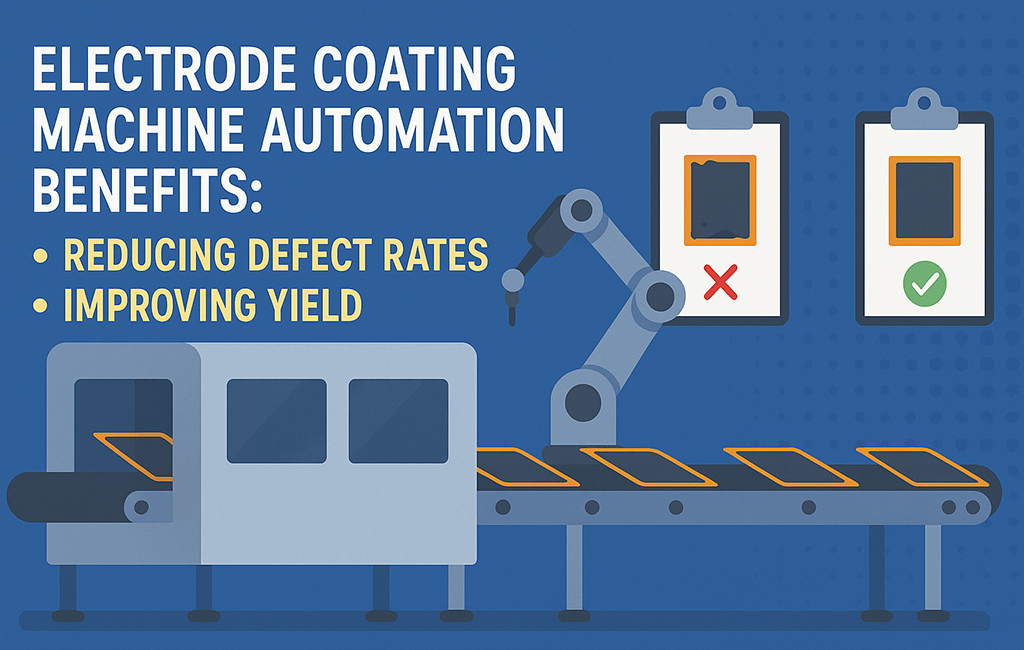Modern electrode coating machine automation has transformed battery manufacturing. Leading facilities report defect rate reductions from 5-8% to below 0.5% and yield improvements exceeding 15%. These gains directly impact production economics, particularly as gigafactories scale to meet growing EV and energy storage demands.
This engineering guide examines how automated coating systems achieve these improvements through integrated process control, real-time monitoring, and adaptive parameter adjustment. We’ll analyze specific automation features that deliver measurable quality improvements while addressing what current industry literature often overlooks.
How Does Electrode Coating Machine Automation Reduce Defect Rates?
Automated electrode coating machines reduce defects through four primary mechanisms:
1. Closed-Loop Thickness Control
Modern systems like the Wuxi Lead LCP-300 series integrate laser profilometers directly into the coating line. These sensors measure thickness at 1,000 points per second across the web width. When thickness deviations exceed ±2 microns, the system automatically adjusts:
- Slot-die gap positioning (±0.5 micron precision)
- Pump flow rates (±0.1% accuracy)
- Web tension (±0.5N resolution)
- Line speed compensation (response time <100ms)
2. Vision-Based Defect Prevention
High-speed cameras capture 4K resolution images at 120fps. These systems detect:
- Pinholes as small as 50 microns
- Streak formations before they propagate
- Edge waviness exceeding 0.5mm
- Foreign particle contamination >20 microns
The system triggers immediate corrective actions. It adjusts meniscus vacuum pressure, modifies edge guide positions, or activates ultrasonic cleaning cycles.
3. Environmental Control Integration
Automated systems maintain the coating environment within strict parameters:
- Temperature: ±0.5°C
- Humidity: ±2% RH
- Cleanroom particle count: Class 1000 or better
- Solvent vapor concentration: ±5ppm
4. Predictive Slurry Management
Inline rheometers monitor viscosity every 30 seconds. The system automatically adjusts:
- NMP solvent addition (±0.1% by weight)
- Mixing speed (10-500 RPM variable)
- Temperature compensation (-5°C to +5°C)
- Filtration bypass for particle spikes
What Yield Improvements Can Battery Manufacturers Expect?
Field data from three major battery manufacturers demonstrates consistent yield improvements:
| Manufacturer Type | Manual System Yield | Automated System Yield | Improvement | Production Volume |
|---|---|---|---|---|
| EV Battery (21700) | 82.3% | 96.8% | +14.5% | 10 GWh/year |
| ESS (Prismatic) | 85.1% | 97.2% | +12.1% | 5 GWh/year |
| Consumer (Pouch) | 87.4% | 98.1% | +10.7% | 2 GWh/year |
These improvements result from three key factors:
First-Pass Quality Enhancement
Automated systems achieve 98.5% first-pass quality compared to 89% for manual operations. The reduction in rework alone saves 3-4 hours per 1,000m² of coated electrode.
Scrap Reduction
Edge trimming waste decreases from 8-10% to 3-4% through precision edge control. For a 300mm web width, this saves approximately 18mm of material per side.
Startup Waste Minimization
Automated recipe management reduces startup waste from 50-100 meters to 10-15 meters per production run. With 4-6 changeovers daily, this represents significant material savings.
What Competitors Missed: Critical Automation Features for Defect Prevention
While competitors focus heavily on inspection equipment, they overlook crucial automation features that prevent defects from occurring:
1. Dynamic Meniscus Control
Advanced coating machines employ dual-vacuum systems that independently control upstream and downstream meniscus pressure. The Yinghe YH-650 system adjusts vacuum levels in 0.1 mbar increments based on:
- Slurry viscosity changes (measured every 30 seconds)
- Web speed variations (±0.1 m/min)
- Ambient pressure fluctuations (±1 mbar)
- Coating weight targets (±2 g/m²)
2. Adaptive Die Lip Compensation
Thermal expansion of slot-die components causes coating variations. Automated systems compensate through:
- 16-zone thermal mapping across die width
- Individual zone heating/cooling (±0.1°C)
- Automatic shim adjustment for gap uniformity
- Real-time lip parallelism monitoring (±1 micron)
3. Intelligent Edge Bead Control
Unlike simple edge guides mentioned in competitor articles, modern systems employ:
- Pneumatic edge shields with 0.1mm positioning accuracy
- Variable vacuum zones for edge thinning
- Automatic edge bead removal systems
- Width adjustment without production stops
How Do Automated Systems Handle Different Battery Chemistries?
Multi-chemistry flexibility represents a key automation advantage. This capability is often overlooked by competitors focusing on single-application systems:
LFP (Lithium Iron Phosphate) Coating
- Higher viscosity range: 5,000-15,000 cP
- Coating weight: 200-300 g/m²
- Speed range: 20-60 m/min
- Temperature control: 25-35°C
NCM (Nickel Cobalt Manganese) Coating
- Medium viscosity: 3,000-8,000 cP
- Coating weight: 150-250 g/m²
- Speed range: 40-100 m/min
- Temperature control: 20-30°C
Silicon-Carbon Anode Coating
- Low viscosity: 1,000-4,000 cP
- Coating weight: 80-150 g/m²
- Speed range: 60-120 m/min
- Temperature control: 15-25°C
Automated systems store chemistry-specific recipes including:
- 250+ parameter settings per recipe
- Automatic die cleaning sequences
- Solvent changeover procedures
- Quality threshold adjustments
What Are the Specific Process Control Parameters That Reduce Defects?
Automated electrode coating machines monitor and control parameters that manual systems cannot maintain consistently:
Primary Control Parameters
| Parameter | Manual Control Range | Automated Control Range | Impact on Defects |
|---|---|---|---|
| Gap Uniformity | ±5-10 microns | ±0.5-1 micron | 90% reduction in thickness variation |
| Pump Pulsation | ±2-5% | ±0.1-0.2% | 85% reduction in streaking |
| Web Tension | ±5-10N | ±0.5-1N | 75% reduction in wrinkles |
| Drying Temperature | ±2-5°C | ±0.2-0.5°C | 80% reduction in blistering |
Secondary Control Parameters
- Slot-die perpendicularity: ±0.05° (prevents wedge-shaped coating)
- Backing roll runout: <5 microns TIR (eliminates periodic defects)
- Air knife pressure uniformity: ±0.5% (consistent edge definition)
- Substrate pre-treatment corona: ±2% power (adhesion consistency)
How Does Real-Time Data Integration Improve Coating Quality?
Modern coating machines generate 50-100GB of process data daily. Automated systems leverage this through three key mechanisms:
Immediate Corrective Actions
- Thickness deviation >3σ: Automatic gap adjustment within 2 seconds
- Viscosity drift >5%: Solvent injection initiated within 10 seconds
- Particle count spike: Filtration bypass activated within 5 seconds
- Temperature excursion: Zone heating/cooling response within 15 seconds
Pattern Recognition Capabilities
- Identifies periodic defects linked to roll rotation (0.1-10 Hz)
- Detects pump pulsation signatures before visible defects
- Correlates environmental changes with coating quality
- Predicts filter clogging 2-4 hours in advance
Historical Analysis Benefits
- Optimizes preventive maintenance schedules
- Identifies optimal operating windows for each chemistry
- Tracks die wear patterns for replacement planning
- Correlates supplier material variations with defects
What Maintenance Features Sustain High Yield Rates?
Automated maintenance functions ensure consistent performance between scheduled downtimes:
Self-Cleaning Sequences
- Ultrasonic die cleaning: 40kHz, 5-minute cycles
- Automatic solvent flush: 10-50 L/min variable flow
- Die lip polishing: 1000-grit automated pad system
- Filter backflush: Reverse flow at 2x operating pressure
Wear Compensation
- Automatic shim adjustment for die wear (0.1 micron increments)
- Pump seal monitoring with predictive replacement alerts
- Bearing vibration analysis (0.01-10 kHz spectrum)
- Belt tension adjustment (maintains ±1% accuracy)
Calibration Automation
- Daily zero-point checks for all sensors
- Weekly span calibration using certified standards
- Monthly laser alignment verification
- Quarterly full system validation protocol
Integration Challenges: What Manufacturers Must Consider
While competitors emphasize equipment features, practical integration requires addressing:
Existing Line Compatibility
- Communication protocols: OPC-UA, Modbus TCP, EtherCAT
- Physical footprint: 15-25m length, 4-6m width typical
- Utility requirements: 380-480V, 200-500kW, 20-50m³/hr compressed air
- Foundation specifications: ±0.5mm/m flatness, 10-ton/m² loading
Operator Transition
- Initial training: 80-120 hours for lead operators
- Skill requirements: PLC programming basics, statistical process control
- Reduced headcount: Typically 2-3 operators vs. 6-8 for manual systems
- New roles: Data analysts, automation technicians
Quality System Integration
- LIMS connectivity for automatic data logging
- SPC chart generation and alert systems
- Batch genealogy tracking
- 21 CFR Part 11 compliance for medical batteries
Comparing Automation Levels: Semi-Automatic vs. Fully Automatic Systems
Unlike competitor articles that treat automation as binary, practical implementation involves choosing appropriate automation levels:
| Feature | Semi-Automatic | Fully Automatic | Defect Impact |
|---|---|---|---|
| Recipe Loading | Manual selection | Barcode/RFID triggered | 50% fewer setup errors |
| Gap Adjustment | Manual + feedback | Closed-loop control | 75% better uniformity |
| Cleaning Cycles | Operator initiated | Schedule + condition based | 60% less contamination |
| Quality Decisions | Operator judgment | Automatic sorting | 90% consistency improvement |
Equipment Selection Criteria for Maximum Defect Reduction
Key specifications that directly impact defect rates:
Mechanical Precision
- Die manufacturing tolerance: ±2 microns preferred
- Backing roll TIR: <5 microns essential
- Linear guide accuracy: ±1 micron/meter
- Thermal stability: <0.001°C/°C/m
Control System Capabilities
- Sampling rate: >1kHz for critical parameters
- Control loops: >20 independent PID loops
- Data storage: >1TB onboard, expandable
- Remote access: Secure VPN with read/write permissions
Sensor Quality
- Thickness measurement: ±0.5 micron or better
- Temperature sensors: ±0.1°C accuracy
- Pressure transducers: 0.1% full scale accuracy
- Flow meters: ±0.5% of reading
Troubleshooting Common Defects with Automated Systems
Automated systems excel at both preventing and diagnosing defects:
Streaking Defects
- Automatic root cause: System correlates streak position with die zone temperatures
- Corrective action: Adjusts individual zone heating within 30 seconds
- Prevention: Maintains thermal map database for each recipe
- Success rate: 95% elimination without stopping production
Thickness Variations
- Detection: Cross-web scanning at 1mm resolution
- Analysis: FFT identifies periodic vs. random variations
- Correction: Adjusts pump speed, gap, or web tension based on pattern
- Documentation: Automatic SPC charts for customer qualification
Edge Defects
- Real-time monitoring: Dual cameras track edge position ±0.1mm
- Predictive alerts: System warns 30 seconds before edge break
- Automatic response: Adjusts edge shields and vacuum zones
- Yield impact: Reduces edge scrap from 10% to 3% of web width
Industry Standards Compliance Through Automation
Automated coating systems facilitate compliance with:
IATF 16949 Requirements
- Automatic PFMEA risk mitigation through controlled parameters
- MSA compliance via automated gauge R&R studies
- Traceability through integrated lot tracking
- Continuous improvement via trend analysis
ISO 14001 Environmental Standards
- Solvent recovery efficiency: >98% with automated systems
- Energy monitoring: Real-time kWh/m² tracking
- Waste reduction: Documented via automatic yield reports
- Emission control: Integrated VOC monitoring and abatement
Conclusion: Quantifiable Benefits of Electrode Coating Machine Automation
Electrode coating machine automation delivers measurable improvements that justify investment in modern battery production. Defect rates drop from 5-8% to below 0.5% while yields improve by 10-15%. These automated systems provide the consistency required for gigafactory-scale operations.
The key differentiators extend beyond simple inspection systems. They encompass predictive control, multi-chemistry flexibility, and intelligent maintenance functions. As battery demand accelerates, manufacturers who implement comprehensive coating automation gain significant competitive advantages through reduced costs, improved quality, and enhanced production flexibility.
Success depends on selecting appropriate automation levels and ensuring proper integration with existing systems. Manufacturers must maintain focus on the specific parameters that drive defect reduction. With proper implementation, automated electrode coating systems deliver ROI within 12-18 months while establishing the foundation for continued process improvement.



